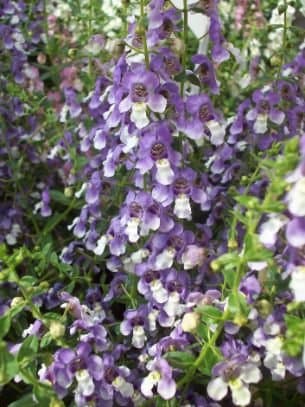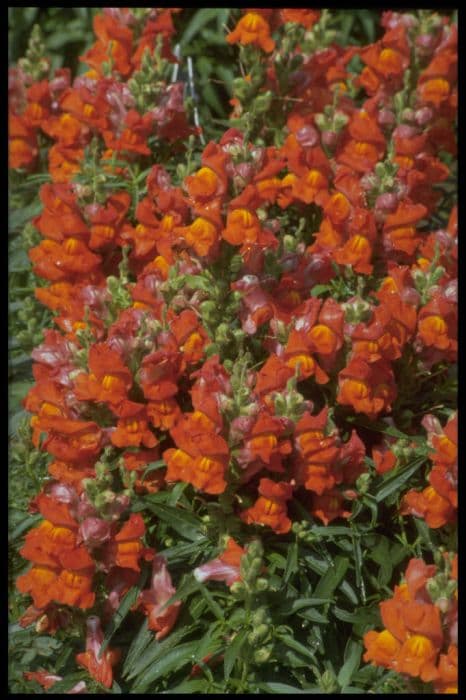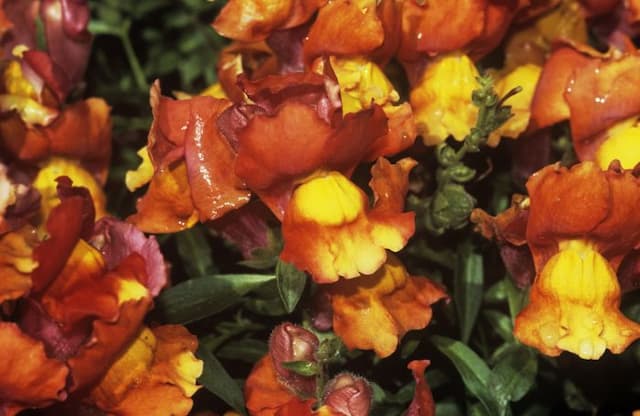Beardtongue Penstemon 'Andenken an Friedrich Hahn'

ABOUT
Penstemon 'Andenken an Friedrich Hahn', commonly known as Beardtongue, is an attractive perennial plant valued for its appealing aesthetic. The plant showcases a bushy clump of deep green foliage, with lance-shaped leaves that create a dense backdrop for its flowers. The blooms are particularly striking, appearing on tall, slender stems that rise above the foliage. These flowers are tubular with a flared mouth, resembling an open bell. They exhibit a rich, velvety crimson color which can range from deep red to maroon, often with a paler throat that may be striped or speckled with contrasting colors. These blossoms are a magnet for pollinators such as hummingbirds and bees, who are drawn to their nectar-rich depths. The flowering period of Beardtongue typically spans from late spring to early summer, providing a long-lasting display of color in the garden.
About this plant
 Names
NamesFamily
Plantaginaceae
Synonyms
Beard Tongue, Beardtongue
Common names
Penstemon 'Andenken an Friedrich Hahn'
 Toxicity
ToxicityTo humans
Beardtongue is not known to be toxic to humans. Ingesting parts of the plant is not typically associated with poisoning or severe symptoms. However, as with any plant material, individual allergies or sensitivities could potentially cause mild discomfort or allergic reactions if ingested.
To pets
Beardtongue is also not known to be toxic to pets. Ingesting parts of this plant is generally considered safe for animals, and it is not associated with poisoning or serious health issues. However, individual pets could experience mild gastrointestinal upset if they consume parts of the plant, which is common with the ingestion of non-food items.
 Characteristics
CharacteristicsLife cycle
Perennials
Foliage type
Semi-deciduous
Color of leaves
Green
Flower color
Red
Height
2 feet 6 inches (76 cm)
Spread
2 feet (60 cm)
Plant type
Herb
Hardiness zones
7
Native area
North America
Benefits
 General Benefits
General Benefits- Attracts Pollinators: The Penstemon 'Andenken an Friedrich Hahn', commonly known as Beardtongue, attracts bees, butterflies, and hummingbirds, which helps pollinate other plants in the garden.
- Drought Tolerance: Once established, Beardtongue is drought-tolerant, making it suitable for xeriscaping or gardens in arid climates.
- Easy to Care For: This plant is generally low-maintenance, requiring minimal watering and feeding.
- Long Blooming Period: Beardtongue has a prolonged blooming season, offering vibrant colors in the garden from late spring to early fall.
- Cold Hardy: It is capable of surviving in colder climates, withstanding lower temperatures and frost conditions.
- Deer Resistant: The plant is typically not favored by deer, helping to maintain the aesthetic of a garden without the need for additional protective measures.
- Versatility in Landscaping: Beardtongue can be used in a variety of garden settings including borders, rock gardens, and as a ground cover.
- Visual Appeal: With its striking tubular flowers and erect habit, it adds both height and color to garden beds and landscapes.
- Soil Adaptability: Beardtongue can grow in a range of soil types, though it prefers well-drained soils.
 Medical Properties
Medical PropertiesThis plant is not used for medical purposes.
 Air-purifying Qualities
Air-purifying QualitiesThis plant is not specifically known for air purifying qualities.
 Other Uses
Other Uses- As a natural dye source: The flowers of the Beardtongue may be used to create natural dyes for fabrics or other crafting projects.
- In pollinator gardens: Beardtongue serves as an attractive plant for pollinators such as bees and hummingbirds, enhancing biodiversity.
- As cut flowers: With their long-lasting blooms, Beardtongue flowers make excellent fresh cut flowers for floral arrangements.
- In rock gardens: Due to their ability to handle dry conditions, they're a great addition for rock or alpine gardens.
- As a photography subject: With vivid flowers and a striking form, Beardtongue plants are often used as subjects for botanical photography.
- In educational gardens: Beardtongue can be used in school gardens to teach about plant-pollinator interactions and native flora.
- For erosion control: Their root systems can help stabilize soil on slopes making them a functional choice for erosion control.
- As edible flowers: While not common, the flowers can be used as a garnish for salads or desserts (only if you're sure they're free from pesticides and other harmful chemicals).
- In xeriscaping: Beardtongue is well-suited to xeriscaping, which is landscaping designed to reduce or eliminate the need for irrigation.
- In winter gardens: Some species of Beardtongue can add interest to winter gardens with their persistent seed heads after flowering.
Interesting Facts
 Feng Shui
Feng ShuiThe Beardtongue is not used in Feng Shui practice.
 Zodiac Sign Compitability
Zodiac Sign CompitabilityThe Beardtongue is not used in astrology practice.
 Plant Symbolism
Plant Symbolism- Perseverance: Penstemon, also known as Beardtongue, often symbolizes the ability to thrive in challenging conditions as it is known for being hardy and able to grow in harsh environments.
- Boldness: Beardtongue can come in vivid colors and has a distinct appearance, which can represent standing out or having the courage to be unique.
- Communication: Its tubular flowers are associated with facilitating communication and the flow of ideas, perhaps due to their open and inviting shape.
- Versatility: As Penstemon can adapt to various soil types and climates, it can symbolize versatility and the ability to succeed in different settings.
 Water
WaterBeardtongue requires regular watering, especially during the growing season. It should be watered deeply once a week, providing about 1 inch of water which roughly translates to 0.6 gallons per square yard of soil. Ensure the soil is well-draining to prevent waterlogging. During hot, dry periods, you may need to water twice a week. Reduce watering in the fall as the plant prepares for dormancy, and water sparingly in winter only if the soil is completely dry.
 Light
LightBeardtongue thrives in full sun to partial shade. The ideal location is a spot that receives at least six hours of direct sunlight daily. However, in extremely hot climates, some afternoon shade can be beneficial to prevent scorching of the leaves.
 Temperature
TemperatureBeardtongue can withstand a wide range of temperatures, but it grows best between 60°F and 75°F. It is cold hardy and can survive minimum temperatures down to 20°F. To ensure healthy growth, avoid locations where temperatures frequently drop below this range or exceed 90°F.
 Pruning
PruningPruning Beardtongue promotes vigorous growth and abundant blooming. Deadhead spent flowers to encourage new blooms. In late winter or early spring, prune back the plant to about 3 inches above ground level to maintain shape and remove any dead or damaged stems. Pruning once a year is typically enough.
 Cleaning
CleaningAs needed
 Soil
SoilBeardtongue requires well-drained soil enriched with organic matter; mix in sand for drainage if needed. Maintain a pH of 6.0 to 8.0.
 Repotting
RepottingRepot the Beardtongue every 3-5 years to refresh the soil and prevent crowding of the roots.
 Humidity & Misting
Humidity & MistingThe Beardtongue prefers average to low humidity conditions; it does not require high humidity.
 Suitable locations
Suitable locationsIndoor
Ensure bright light, minimal watering, and good air circulation.
Outdoor
Plant in full sun, well-draining soil, protect from harsh winds.
Hardiness zone
4-9 USDA
 Life cycle
Life cycleBeardtongue 'Andenken an Friedrich Hahn' begins its life as a seed, which upon finding suitable conditions, germinates and grows into a seedling. The seedling then develops true leaves and establishes a root system as it enters the vegetative stage, during which it grows steadily. When mature and environmental conditions are favorable, usually in spring or early summer, the plant enters the flowering stage, producing tall spikes of tubular, deep burgundy flowers that attract pollinators. After pollination, flowers develop into fruit capsules containing numerous small seeds. As the growing season ends, the plant may die back, especially if it is grown in a colder climate, entering a period of dormancy. The cycle is completed when the plant resumes growth from the rootstock or seed the following season, depending on how it overwinters and the conditions of its habitat.
 Propogation
PropogationPropogation time
Spring-Early Summer
The Penstemon 'Andenken an Friedrich Hahn', also known as Beardtongue, is commonly propagated through stem cuttings. This method is particularly popular due to its effectiveness and relative simplicity. To propagate Beardtongue using stem cuttings, you should ideally take cuttings in late spring or early summer when the plant is actively growing. The cuttings, which should be about 3 to 5 inches (approximately 7.6 to 12.7 centimeters) long, are taken from healthy, non-flowering stems. Each cutting should have several leaf nodes, and the leaves on the lower half of the cutting are removed. The base of the cuttings should then be dipped in rooting hormone powder to encourage root development and then placed in a well-draining soil mix. Provide consistent moisture and maintain a warm environment to help root formation, which typically takes several weeks. Once the cuttings have rooted, they can be transplanted into individual pots or into the garden.









